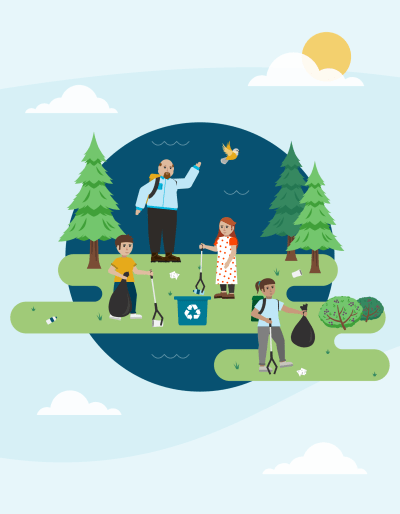Take steps to reuse and recycle
Learn about the impacts of plastics, play a movement game to discover alternatives, and create a reusable bag tag.

Overview
The theme for Earth Day 2024 is "Planet vs Plastics". Students will discover how plastics can be harmful by participating in an interactive quiz, then play a movement game to look for reusable alternatives to plastic items and create a ‘bag’ tag to remind us to take our reusable bags shopping.
Participate as a class
A single screen and laptop is used for watching the video and answering questions together as a class.
Before you begin, make sure:
- You’re connected to the internet
- You’re projecting your screen for the class to see

Launch activity Commencer l'activité
Need help with using quiz activities in the classroom?
Check out
our
Getting started guide.
Instructions
What you'll need
- TV or computer and projector connected to the internet
- “A better choice” matching cards, print both sheets and cut out
- Take note of each page – one is to be printed on red paper, one on blue paper. Colours can be altered based on availability. Important point is that non-plastic items are one colour, and plastic items are another colour.
- “Reusable bag” student template, one copy per student
- Scissors, glue stick, and colouring crayons or markers for each student
- String cut into approximately 20cm long, one piece per student
Let’s keep everyone safe
- Introduce students to Earth Day 2024. Explain it's held annually on April 22 to help protect the planet. This year’s theme focuses on Planet vs. Plastics to raise awareness of how plastics affect all living things.
- Ask students to look around the classroom and identify items made of plastic, examples include: pens, lunch containers, projector, and computers.
- Share that many things in our lives are made of plastic. Plastic can be very useful, but it can also cause problems in our world if we aren’t careful. Discuss the difference between single-use plastics and reusable plastics.
- Single-use plastics are lower quality, designed to only be used one time and then thrown out or recycled.
- Reuseable plastics are meant to be used for a long time like reusable water bottles to replace ‘one time’ single-use water bottles.
- Launch the “interactive quiz” and choose one of these options:
- Allow students to vote on what they think the answer is by using individual whiteboards to write the answer.
- Have A, B, C, D written on pieces of paper which they can hold up.
- Assign different corners of the classroom to each letter and let students move to their chosen answer.
- Complete the quiz together.
- Review some of the problems with plastics especially single-use plastics.
- Plastics will last for hundreds of years because they can’t be composted like banana peels, they don't degrade or breakdown easily.
- If plastics end up in the ocean or on land, animals can eat them and get sick.
- To make plastic, we use energy, water, and oil which is a waste if we only use them once and throw them away.
- Remind students that there are things we can do to help with this problem. Ask students to share ideas. Answers may include:
- Making sure we don’t litter.
- Putting our items in the correct bin (garbage, recycling).
- Using fewer single-use plastics, and using our reusables instead like reusable water bottles and forks.
- Pack zero-waste lunches without any garbage.
- Have litter clean-ups at school, parks, beaches and around the neighborhood.
A better choice
- Use the “A better choice” matching cards to play a game. Tell students that some of them will have a card with a single-use plastic item like a plastic straw and some will have a reusable item like a metal straw. They're to move around the room looking for the student with the opposite card to match the plastic item with its non-plastic alternative. Review the cards with students before they play the game.
- Place the cards into two piles shuffled and face down. One pile are single-use plastic items (printed on red paper), and one pile are reusable and non-plastic items (printed on blue paper). Have students make two lines and take one card each. Students will look for their match and once they've found their partner the pair should sit down together.
- Ask students to name the single-use item and the the reusable alternative.
- Ask students to share their ideas about why a reusable item could be better than the disposable one.
- Continue playing the game with students having different cards.
Hands-on craft reusable bag tags and contest
- Discuss that we can reduce plastic use by using reusable alternatives like cloth bags for groceries, however, we sometimes forget these. Tell students we'll create a reminder to bring reusable bags to the stores.
- Provide each student with the “reusable bag” student template to decorate by colouring.
- Next, cut out the template, glue the front and back together, and make a hole in the handle.
- Loop a string through the handle and tie a knot to turn the bag into a hanging reminder. Students can hang give these to their parents to hang on a rearview mirror of a car or on a hook by their front doors to remind everyone to take reusable bags to the store.
- Share photos of your students' reusable bag tags to be entered into a prize draw.
Modify or extend this activity
- Play the matching in a silent round by only showing cards and a charades round acting it out without showing the card.
- Visit Earth Day 2024 and try the additional activities and educational resources.
- Connect this lesson with a clean up activity, such as picking up litter in the school yard or at a park nearby.
Curriculum Fit
These Earth Day activities provide a link to the core competencies of the curriculum. The activities engage students in taking action on reducing plastics in our lives.
Communications
- Connect and engage with others (to share and develop ideas)
- Working collectively
Thinking
- Creative thinking: generating ideas
- Critical thinking: analyze and critique / question and investigate
Social Awareness and Responsibility
- Contributing to community and caring for the environment
The activities also connect to a variety of grade-specific curricular competencies and content in a variety of subjects including Arts Education, Science and Social Studies.
Assessments
- Assess students’ understanding of the harms of single-use plastics, especially in the environment.
- Assess students’ ability to think critically and identify reusable items to replace single-use plastic items.
- Assess students’ cooperation and collaboration in the matching activity.
Teaching Notes
What is Earth Day?
Earth Day is held annually on April 22nd with the aim of driving a year of energy, enthusiasm, and commitment to create a new plan of action for our planet.
This year's theme is Planet vs Plastics: focusing on health risks to all, demanding change and innovative solutions to achieve a 60% reduction of plastic production by 2040.
Facts about plastic
Excerpt from Earthday.org
“The word environment means what surrounds you. In the case of plastics we have become the product itself – it flows through our blood stream, adheres to our internal organs, and carries with it heavy metals known to cause cancer and disease. Now this once-thought amazing and useful product has become something else, and our health and that of all other living creatures hangs in the balance,” said Kathleen Rogers, President of EARTHDAY.ORG. “The Planet vs. Plastics campaign is a call to arms, a demand that we act now to end the scourge of plastics and safeguard the health of every living being upon our planet.”
Plastics extend beyond an imminent environmental issue; they present a grave threat to human health as alarming as climate change. As plastics break down into microplastics, they release toxic chemicals into our food and water sources and circulate through the air we breathe. Plastic production now has grown to more than 380 million tons per year. More plastic has been produced in the last ten years than in the entire 20th century, and the industry plans to grow explosively for the indefinite future.
“All this plastic was produced by a petrochemical industry with an abysmal record of toxic emissions, spills, and explosions,” said Denis Hayes, Chair Emeritus of EARTHDAY.ORG. “Plastics are produced in polluting facilities that somehow seem to always be located in the poorest neighborhoods. Some plastics are lethal when combusted; other plastics transmit hormone-disrupting chemicals; and all plastics can starve birds and suffocate sea life. At every stage of their life cycles, from the oil well to the town dump, plastics are a dangerous blight.”
More than 500 billion plastic bags—one million bags per minute—were produced worldwide last year. Many plastic bags have a working life of a few minutes, followed by an afterlife of centuries. Even after plastics disintegrate, they remain as microplastics, minute particles permeating every niche of life on the planet.
100 billion plastic beverage containers were sold last year in the United States. That’s more than 300 bottles per inhabitant. A few of them will be converted into park benches; none of them will be made into new plastic bottles and 95% of all plastics in the US won’t be recycled at all. Even the 5% of plastics being recycled are “downcycling” to inferior products or shipped to poorer countries for “recycling”, leaving the demand for virgin plastic undiminished.
People seldom think of water when they think of plastics. But making a plastic water bottle requires six times as much water as the bottle itself contains.
EARTHDAY.ORG demands the International Negotiating Committee on Plastic Pollution (INC) mandate the end of production of single-use plastic by 2030 in the Global Plastics Treaty. Moreover, it demands the treaty be implemented using the precautionary principle and the polluter pays doctrine.
Young people can take action
Young people can act at school, in their community and at home to protect and care for the planet. We can empower them with a deeper understanding of our responsibility to take care of the planet we depend on, and the plants and animals that live here too.
BC Hydro and protecting the environment
Check out BC Hydro’s news story on microplastic pollution from laundry.
According to UBC's Decision Insights for Business & Society, the path to change isn't always around energy cost savings or carbon emission reductions. At least with Team Power Smart members, the messaging that most drives energy efficient laundry behaviours focuses on the link between laundry and the generation of microplastics affecting turtles and other sea life.
Did you know that a single load of laundry – when machine washed in hot water and machine dried with hot air – produces between 700,000 and 12 million microfibres that end up in our oceans? It's estimated that laundry is responsible for 35% of microplastics in oceans, and that there are relatively easy ways to reduce that number:
- Re-wear clothes until they're dirty
- Combine loads to run fewer, larger loads of laundry
- Wash laundry in cold water
- Hang-dry laundry inside or outside, as much as possible
We'd like to hear from you
We want to ensure that we’re providing activities your class will enjoy. Please let us know what you think about this activity by leaving us your feedback.






